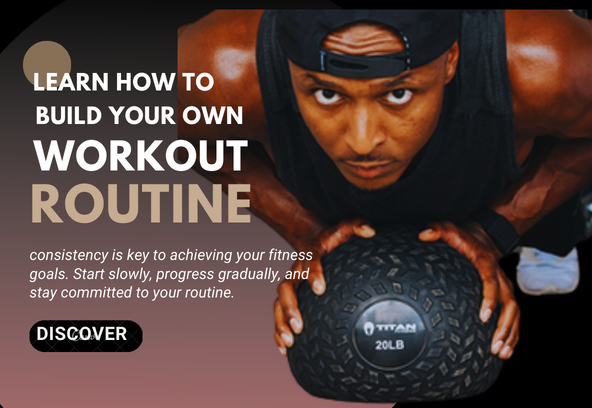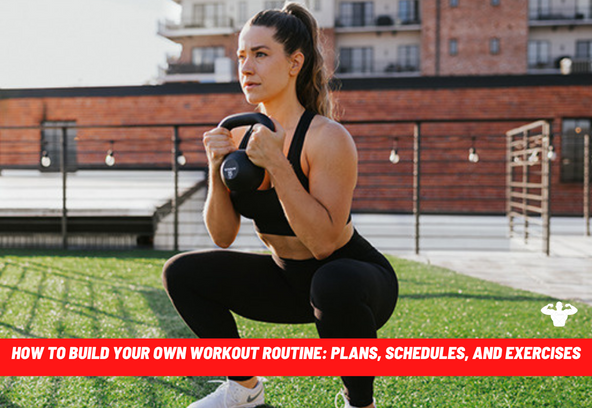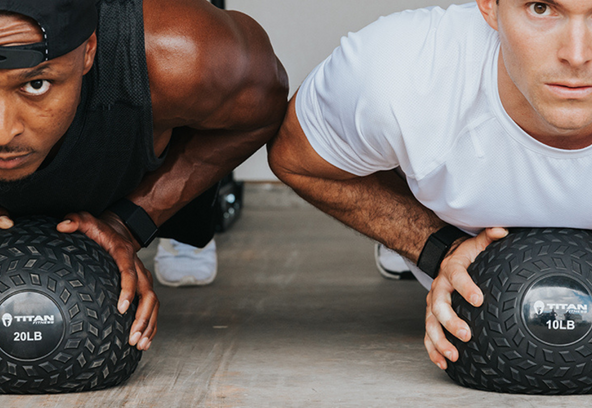
How to Build Your Own Workout Routine: Plans, Schedules, and Exercises

Making a personal training schedule is a rewarding and pleasurable task that lots of people want to complete. You may improve the look of your body by finding the ideal ratio of cardio, strength training, and rest time. But those who want to develop a regular exercise practice frequently have a number of questions about designing a regimen that works.
You will have a lot of things to consider while starting your personal training regimen. Which exercises are best for your particular body type? How many sets and reps are necessary to increase muscle mass? How frequently should breaks be taken? How quickly should you raise your lifting capacity and training time? There are so many things to think about! This thorough guide digs into every crucial component of creating an efficient workout schedule, enabling you to start your fitness journey with confidence.

Read on to find out everything you need to know about creating a workout routine that works for you, regardless of whether you are an experienced weightlifter wanting to update your exercise schedule or create your first workout plan.
How to Build A Workout Routine
The process of creating a fitness program can be intimidating, especially when you first begin. There are several things to think about, including the exercises to complete, the number of sets and reps, and the frequency of breaks. The following stages will assist you in developing a training regimen that is effective for you:
Determine your fitness goals
First things first: what are your goals for your exercise program? Do you want to get thinner? Would you like to gain muscle? Are you preparing for a marathon or a 5k? Whatever your objectives, you should put them in writing and keep them in front of your mind so that you are aware of what you want to accomplish. Your objectives will guide you in creating a fitness plan that will help you reach your objectives.
Try adopting the SMART technique while setting goals of any kind, particularly when it comes to fitness goals. The acronym SMART stands for:
- Specific: Ensure that your goals clearly and succinctly describe what you hope to achieve.
- Measurable: Your objectives must enable you to track your advancement. For instance, perhaps you have a deadline for losing 5 pounds. Or maybe your goal is to be able to perform ten bench presses with a specific weight. Be sure you can link your objectives to observable milestones, no matter what they are.
- Realistic goals are more likely to be accomplished. The length of time it takes to lose weight, build muscle, etc., will vary depending on your body weight and BMI.
- Keep your goals in line with your hobbies, preferences, aptitudes, etc. For instance, making a goal to run x miles won’t matter if you detest jogging or have a leg ailment.
- Timely: Create a timeline for your objectives to make sure you maintain a regular schedule without putting yourself in danger of harm.
What has been successful in the past?
The likelihood that you can continue with a certain sort of training and achieve benefits is quite good if it has previously produced positive outcomes for you. Think about the exercises that motivated you to train and the ones that you found boring. In this manner, you will have a starting point for your actions.

How much time can you commit to your exercise objectives?
You must also decide how much dedication you can give to your training and goals. Your work schedule, lifestyle, family life, social commitments, etc. will all play a major role in this. For most people, training 3-5 days per week is a good objective. You can begin scheduling your days to create a training split and training frequency once you’ve decided how many days a week you’ll train.
Determine the number of sets and reps
Your outcomes may be significantly impacted by the number of sets and reps you do throughout a workout. You should perform exercises with heavier weights and fewer repetitions, often 4-6 sets of 6–12 repetitions, if you want to gain muscle. If your goal is to tone and sculpt your body, you should use lighter weights and more repetitions—typically 3 sets of 12–15.
How frequently you exercise a muscle is referred to as training frequency. Typically, people begin by working out a muscle group twice or three times per week. This implies a total of 12–18 sets per week. In order to get the best results and monitor your progress early on, it’s a good idea to experiment with how many sets and reps you do.
Create a workout schedule
You must decide how frequently you’ll exercise and which days you’ll focus on which muscle groups before you can create a plan. For instance, you could wish to concentrate on certain muscle parts on various days, such as the legs on Monday, the arms on Wednesday, and the back on Friday.
Here are five methods for making a schedule for exercising:
- Set fitness objectives: Decide what you hope to accomplish with your workouts. Do you wish to gain strength, burn fat, become more flexible or increase your endurance? Make a training regimen based on your objectives and incorporate workouts that will aid in achieving those objectives.
- Consider your work schedule, family duties, and other commitments when determining your availability. Create a timetable that works with your availability to exercise by deciding what days and hours work best for you.
- Pick your exercise routine: Choose the exercises you want to incorporate into your program. Yoga, cardio, strength training, or a combination of these may be included in this. To prevent boredom and to push your body, make sure you vary your regimen.
- After deciding on your fitness objectives, availability, and workout routines, make a plan. This can entail making a weekly or monthly schedule outlining the exercises you’ll perform every day, the number of sets and reps you’ll perform, and how much time you’ll spend on each activity.
- Respect your schedule: When it comes to exercise, consistency is important. Try to keep to your schedule as much as you can, and alter it as necessary. As you reach your fitness goals or face challenges, monitor your progress and change your workout routine.
Start slowly and progress gradually
The intensity of your workouts should be gradually increased after a sluggish start. Injury and burnout will be less likely as a result. Increasing weight or reps by no more than 10% a week is a solid general rule of thumb.
To achieve your fitness goals at their full potential without risking injury or burnout, you must start out cautiously and build up your endurance gradually. You can follow the instructions listed below:
- Contact a healthcare professional before beginning any new exercise regimen: If you have any pre-existing medical illnesses or injuries, it is very vital to consult a healthcare practitioner before beginning any new exercise regimen.
- Create attainable long-term goals: It’s critical to have attainable long-term goals. This keeps you motivated and keeps you from getting discouraged.
- Pick a workout that you like: Choose a workout that you like to do and that matches your lifestyle. Walking, cycling, swimming, weightlifting, or yoga are all examples of this.
- Include rest days in your exercise program: It’s critical to include rest days in your workout routine. This promotes injury prevention and allows your body to heal.

Monitor your Progress
By recording your workouts and keeping an eye on your weight, body fat percentage, and strength gains, you can track your progress. This will support your motivation and allow you to modify your workout plan as necessary.
WHAT ACTIVITIES SHOULD YOU INCLUDE IN YOUR EXERCISE?
When deciding which exercises to include in your fitness program, there are so many options available that it can be daunting. Creating an exercise routine that lays the groundwork for future success is the most crucial aspect of strength, muscular gain, and general health. The following are a few of the most crucial factors to think about while selecting how to create a fitness regimen.
Body Weight Exercises
Bodyweight exercises are just what they sound like. Instead of lifting or pushing weights, you move your own body weight throughout these exercises. You can improve your form in other motions by getting a good grip on bodyweight movements. The primary bodyweight exercises are lunges, single-leg squats, jumps, push-ups, pull-ups, and more.
Compound Exercises
Complex exercises are essential for developing muscle. These exercises simultaneously work for several muscle groups. They, therefore, involve many joints moving together in tandem to flex, extend, and/or rotate. They use less time and exert higher loading stress by working out more muscles simultaneously. The overhead press, rows, and deadlift are examples of common compound exercises.
Compound lifting can, however, have some drawbacks to be aware of. Muscle isolation can be difficult, movement efficiency can occasionally be decreased by muscle exhaustion, and correcting movement imbalances can be difficult.
Accessories Movements
The purpose of accessory exercises is to supplement the primary lifts in your workout and aid in your long-term growth. They help you achieve your exercise goals by enhancing your balance, coordination, and strength. You may spice up your workouts with accessory motions to provide variety, originality, and pleasure.
The time has come to start your fitness journey.
It’s difficult to go wrong with a full-body program when figuring out how to create a fitness routine that is effective for your body. They allow you to train the major muscle parts more than once a week and can help you build a fitness program while also keeping your calendar quite easy. If your primary motivation for working out is overall health rather than appearance, full-body exercises are also fantastic. Also, whether you are exercising in a gym or at home, they take up a lot less time.
Conclusion
In conclusion, creating your personal exercise regimen can be a difficult but worthwhile task. You can develop a plan that is customized to your fitness objectives, tastes, and lifestyle by following the steps provided in this article. Regardless of your level of athletic ability, it’s critical to build a strong base of strength, stamina, and flexibility before moving on to more difficult exercises and routines. To sustain motivation and reach your fitness goals, keep your commitment strong, monitor your development, and make any plan modifications. You can design a fitness regimen that makes you feel strong, healthy, and confident if you put effort into it, are consistent about it, and are a little bit creative about it.


